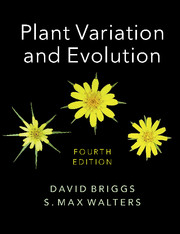Book contents
- Frontmatter
- Contents
- Preface to the Fourth Edition
- Acknowledgements
- Note on names of plants
- List of abbreviations
- 1 Investigating plant variation and evolution
- 2 From Ray to Darwin
- 3 Early work on biometry
- 4 Early work on the basis of individual variation
- 5 Post-Darwinian ideas about evolution
- 6 DNA: towards an understanding of heredity and molecular evolution
- 7 Breeding systems
- 8 Intraspecific variation and the ecotype concept
- 9 Pattern and process in plant populations
- 10 Pattern and process: factors interacting with natural selection
- 11 Populations: origins and extinctions
- 12 Species and speciation: concepts and models
- 13 Allopatric speciation and hybridisation
- 14 Abrupt speciation
- 15 The species concept
- 16 Flowering plant evolution: advances, challenges and prospects
- 17 Historical biogeography
- 18 The evolutionary impact of human activities
- 19 The taxonomic challenge ahead
- 20 Conservation: from protection to restoration and beyond
- Glossary
- References
- Index
10 - Pattern and process: factors interacting with natural selection
Published online by Cambridge University Press: 05 June 2016
- Frontmatter
- Contents
- Preface to the Fourth Edition
- Acknowledgements
- Note on names of plants
- List of abbreviations
- 1 Investigating plant variation and evolution
- 2 From Ray to Darwin
- 3 Early work on biometry
- 4 Early work on the basis of individual variation
- 5 Post-Darwinian ideas about evolution
- 6 DNA: towards an understanding of heredity and molecular evolution
- 7 Breeding systems
- 8 Intraspecific variation and the ecotype concept
- 9 Pattern and process in plant populations
- 10 Pattern and process: factors interacting with natural selection
- 11 Populations: origins and extinctions
- 12 Species and speciation: concepts and models
- 13 Allopatric speciation and hybridisation
- 14 Abrupt speciation
- 15 The species concept
- 16 Flowering plant evolution: advances, challenges and prospects
- 17 Historical biogeography
- 18 The evolutionary impact of human activities
- 19 The taxonomic challenge ahead
- 20 Conservation: from protection to restoration and beyond
- Glossary
- References
- Index
Summary
Chance has profound effects
It is important first to differentiate between chance events and those that involve natural selection. Ridley (1996) provides an elegant example. He imagines a long line of loaded packhorses toiling, in single file, up a long precipitous mountain track. Clearly, elements of natural selection might be important, as some animals might be inherently more nimble and survive the journey in greater numbers than clumsy horses that fall to their death. However, in his example, the hazards of the alpine journey also include massive falling rocks that sweep horses to their death into the ravine below. Animals are not genetically predisposed to avoid the sudden chance arrival of massive falling rocks. The important point to emphasise is that horses swept off the track by such chance events are likely to be a random sample from the original population that started out on this hazardous journey. Furthermore, a new mutant horse – more sure footed than the average – might by chance be carried away with others of lesser fitness. The potential of this mutation is, therefore, not realised. Chance determines which, of a group of horses, survive the falling rocks.
Chance effects – so-called stochastic events – play a major role in all evolutionary processes, not only in chromosomal and DNA changes, but also in hybridisation, speciation and extinction. In population biology, for instance, chance plays a huge role in which flowers are pollinated by animals/wind, and which seeds/fruits are dispersed to ‘safe sites’ allowing successful germination. Indeed, the effect of chance is highly significant in all the processes of population biology: dispersal, establishment, growth and reproduction.
Random genetic change in populations is known as genetic drift or in the older literature as the ‘Sewall Wright’ effect. ‘Alleles may be fixed or lost, especially from small populations, because of random sampling errors and without regard to their adaptive values’ (King, Stansfield & Mulligan, 2006). Thus, chance effects are particularly important if the population is reduced by a bottleneck effect to a very small size (Fig. 10.1). Wright (1931) was the first to point out that, in such small populations, irregular random fluctuations in gene frequency occur that may result in the fixation or loss of one or more alleles. Such chance effects may be very important also in the declining populations of endangered species.
- Type
- Chapter
- Information
- Plant Variation and Evolution , pp. 201 - 215Publisher: Cambridge University PressPrint publication year: 2016

